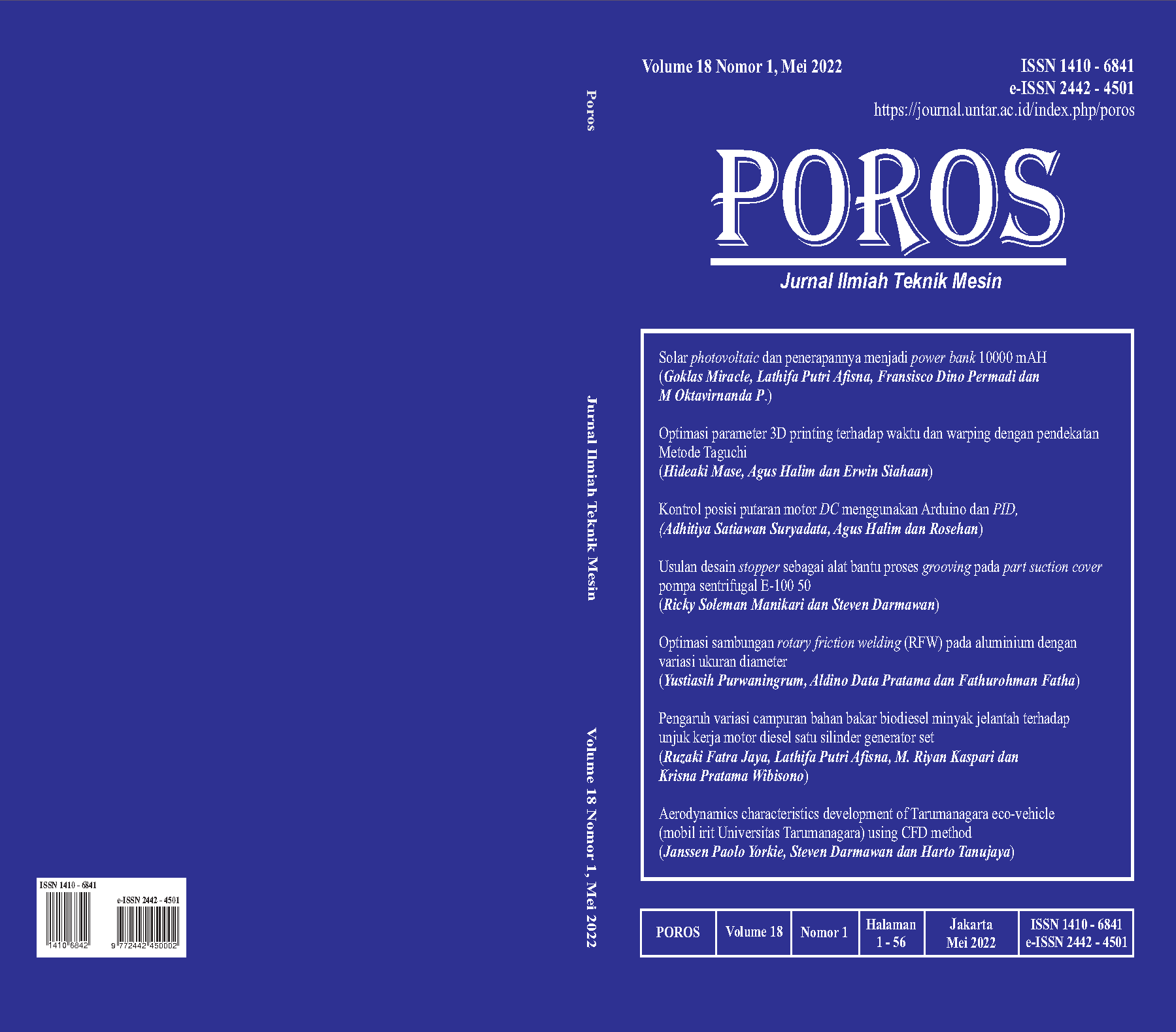AERODYNAMICS CHARACTERISTICS DEVELOPMENT of TARUMANAGARA ECO-VEHICLE (MOBIL IRIT UNIVERSITAS TARUMANAGARA) USING CFD METHOD
Main Article Content
Abstract
Vehicles experience the forces of aerodynamics at various degrees and magnitude. The impact of aerodynamic must be considered because it affects the efficiency of the object. Because aerodynamic forces highly affect a vehicle’s efficiency, improvement in aerodynamics characteristics will improve the vehicles efficiency. However, the aerodynamic characteristic involves vehicle profile, dimensions. Designers now have the option of using a CFD software to simulate and calculate the aerodynamic properties of an object before production. The 2 objects on this research are an improved version of Mobil Irit Universitas Tarumanagara body by modifying its length therefore reducing the angle of the body, the body is named 3a and 3b. CFD simulation of body 3a and 3b is used to determine whether the flow characteristic is improved by the length modification of the object, and will be done using ANSYS Workbench R1 Academics Version at 5 different inlet velocity (1,39 m/s; 2,78 m/s; 4,17 m/s; 5,56 m/s; and 12,5 m/s) and will use a 3D simulation with single phase fluid. Subject 3a has 42699 nodes 234941 elements, subject 3b has 49535 nodes 272509 elements. The result shows a reduction in wake size at the back of subject 3b, whereas wake size increased in subject 3a. The drag coefficient result in reduction on 3b and an increase in 3a.
Article Details

This work is licensed under a Creative Commons Attribution-NonCommercial-ShareAlike 4.0 International License.

This work is licensed under a Creative Commons Attribution-NonCommercial-ShareAlike 4.0 International License.
References
References
M. N. Sudin, M. A. Abdullah, S. A. Shamsuddin, F. R. Ramli, and M. M. Tahir, “Review of research on vehicles aerodynamic drag reduction methods,” Int. J. Mech. Mechatronics Eng., vol. 14, no. 2, pp. 35–47, 2014.
J. Katz, “Aerodynamics of race cars,” Annu. Rev. Fluid Mech., vol. 38, pp. 27–63, 2006, doi: 10.1146/annurev.fluid.38.050304.092016.
SHELL, “Shell ECO MARATHON OFFICIAL RULES 2021 Chapter 1,” vol. 1, no. 1, p. 59, 2020.
P. Kesuma, S. Darmawan, and A. Halim, “Aerodynamics analysis of mobil irit tarumanagara using CFD method,” IOP Conf. Ser. Mater. Sci. Eng., vol. 1007, no. 1, 2020, doi: 10.1088/1757-899X/1007/1/012032.
J. Paolo, “CFD Analysis of Flow Around AF1300a Cylinder Model at Reynolds Number Variation,” Publ. Pending, no. 1.
MHRD, “Module 4 : Lecture 1 COMPRESSIBLE FLOWS (Fundamental Aspects: Part - I),” NPTEL – Mech. – Princ. Fluid Dyn., pp. 1–57, [Online]. Available: https://nptel.ac.in/courses/101103004/pdf/mod4.pdf.
S. Ideen, “Aerodynamic Basics,” pp. 0–234, 2018, [Online]. Available: https://denmachines.com/2017/07/26/aerodynamic-basics/.
J. M. C. Yunus A. Cengel, Fluid Mechanics. Pennsylvania, 1377.
K.-J. Bathe, Computational fluid and solid mechanics 2003[ Recurso electrónico] :] proceedings, Second MIT Conference on Computational Fluid and Solid Mechanics, June 17-20, 2003. 2003.
J. Wang, H. Li, Y. Liu, T. Liu, and H. Gao, “Aerodynamic research of a racing car based on wind tunnel test and computational fluid dynamics,” MATEC Web Conf., vol. 153, pp. 1–5, 2018, doi: 10.1051/matecconf/201815304011.
R. Merrick and G. Bitsuamlak, “Control of flow around a circular cylinder by the use of surface roughness,” pp. 1–15, 2008.
S. H. S.P and W. A. Widodo, “Karakteristik Wake Area Akibat Efek Penggunaan Vortex Generator di Belakang Wing Airfoil Naca 43018,” J. Penelit., vol. 4, no. 1, pp. 55–63, 2019, doi: 10.46491/jp.v4e1.287.55-63.



